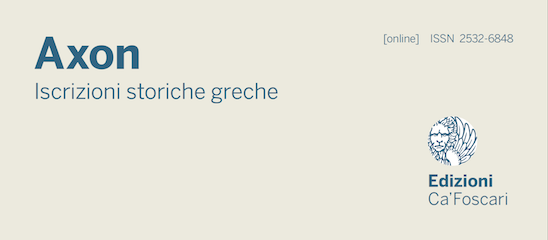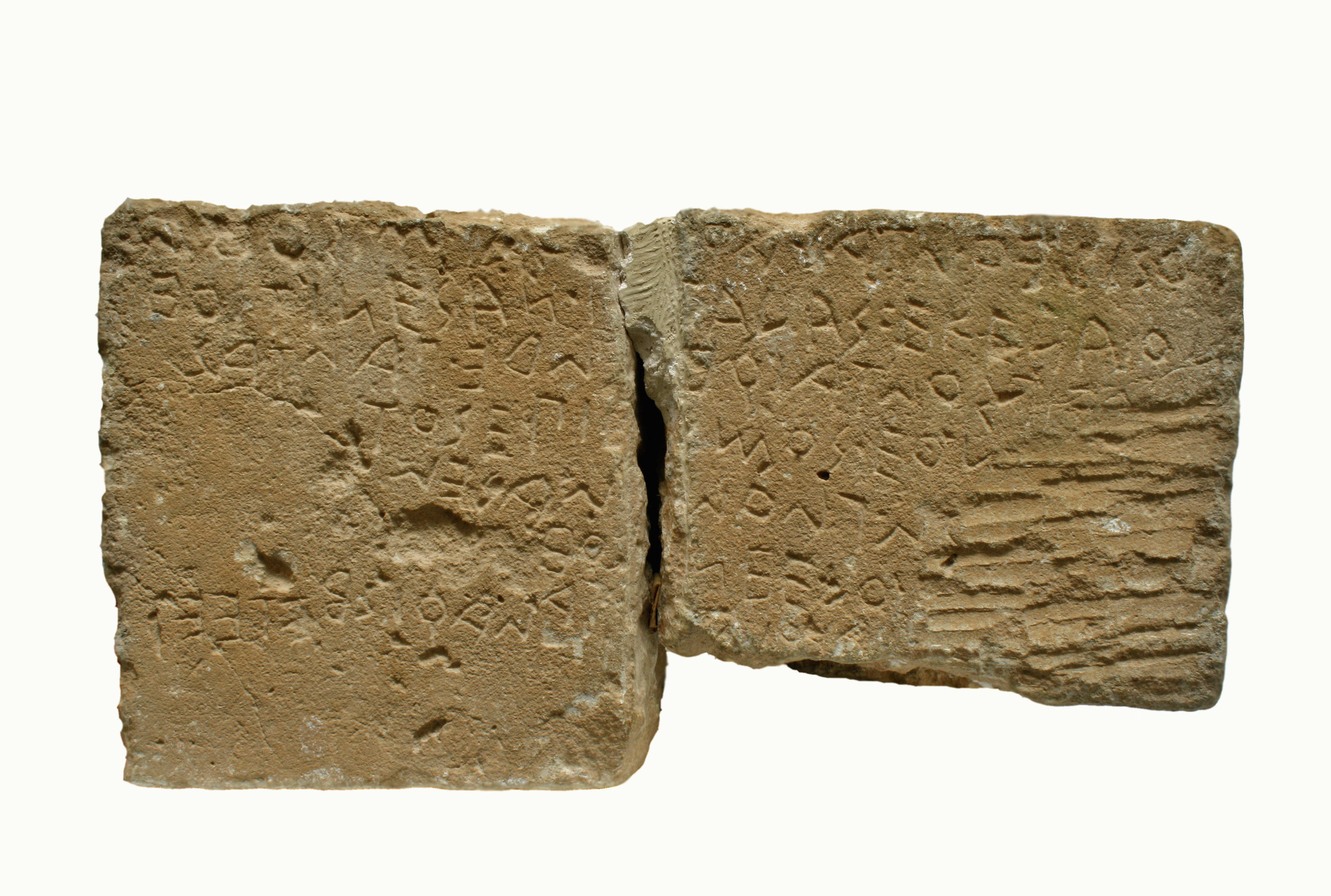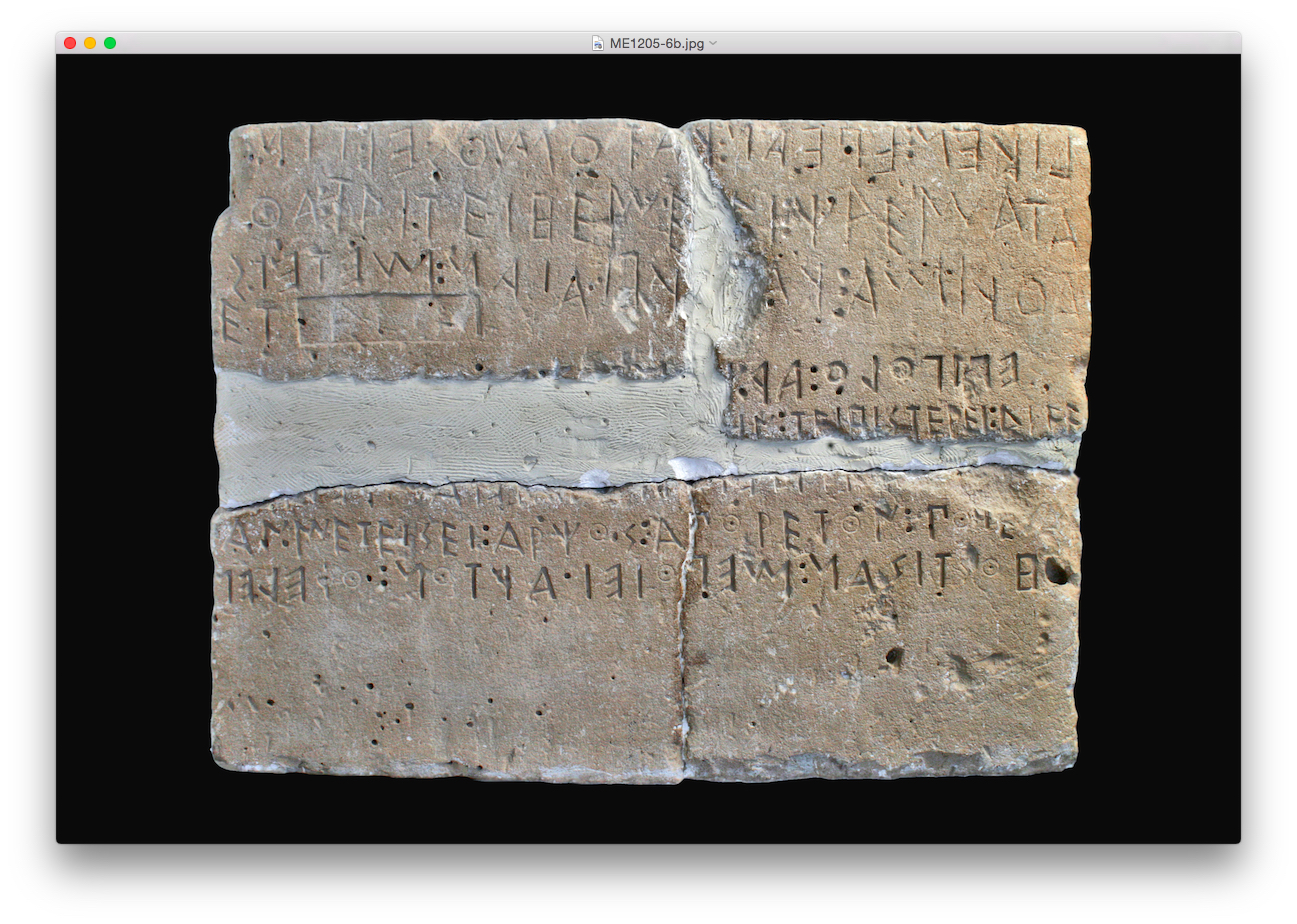van Effenterre - Ruzé, Nomima I = van Effenterre, H.; Ruzé, F. (1994). Nomima. Recueil d'inscriptions politiques et juridiques de l'archaïsme grec, I. Rome (Bibliothèque des Écoles Françaises d’Athènes et de Rome 188; https://www-perseefr.bibliopam-evry.univ-evry.fr/web/ouvrages/home/prescript/monographie/efr_0000-0000_1994_cat_188_1).
van Effenterre - Ruzé, Nomima I = van Effenterre, H.; Ruzé, F. (1994). Nomima. Recueil d'inscriptions politiques et juridiques de l'archaïsme grec, I. Rome (Bibliothèque des Écoles Françaises d’Athènes et de Rome 188; https://www-perseefr.bibliopam-evry.univ-evry.fr/web/ouvrages/home/prescript/monographie/efr_0000-0000_1994_cat_188_1).
Guarducci, Epigrafia greca I = Guarducci, M. (1967). Epigrafia Greca I. Caratteri e storia della disciplina. La scrittura greca dalle origini all'età imperiale. Roma.
Guarducci, Epigrafia greca I = Guarducci, M. (1967). Epigrafia Greca I. Caratteri e storia della disciplina. La scrittura greca dalle origini all'età imperiale. Roma.
IG XII.9 = Ziebarth, E. (ed.) (1915). Inscriptiones Graecae XII, 9. Inscriptiones Euboeae insulae. Berlin.
IG XII.9 = Ziebarth, E. (ed.) (1915). Inscriptiones Graecae XII, 9. Inscriptiones Euboeae insulae. Berlin.
Koerner, Gesetzestexte = Koerner, R. (1993). Inschriftliche Gesetzestexte der frühen griechischen Polis. Köln.
Koerner, Gesetzestexte = Koerner, R. (1993). Inschriftliche Gesetzestexte der frühen griechischen Polis. Köln.
LSAG² = Jeffery, L.H. (ed.) (1961). The Local Scripts of Archaic Greece. A Study of the Origin of Greek Alphabet and its Development from the Eighth to the Fifth Centuries B.C. Oxford revised edition with a supplement by A.W. Johnston (Oxford 1990).
LSAG² = Jeffery, L.H. (ed.) (1961). The Local Scripts of Archaic Greece. A Study of the Origin of Greek Alphabet and its Development from the Eighth to the Fifth Centuries B.C. Oxford revised edition with a supplement by A.W. Johnston (Oxford 1990).
Boffa, G. (2011). «L’astuzia del polpo. Simbologia monetale e identità in Eretria arcaica». PP, 66, 401-430.
Boffa, G. (2011). «L’astuzia del polpo. Simbologia monetale e identità in Eretria arcaica». PP, 66, 401-430.
Boffa, G. (2012). «Eretria, la città 'rematrice'». PP, 67, 5-41.
Boffa, G. (2012). «Eretria, la città 'rematrice'». PP, 67, 5-41.
Bérard, C. (a cura di) (1970). L’Heroon à la porte de l’ouest. Bern (Eretria III).
Bérard, C. (a cura di) (1970). L’Heroon à la porte de l’ouest. Bern (Eretria III).
Caccamo Caltabiano, M.; Radici Colace, P. (1983). «Argyrion Dokimon ... to d'enantion parasemon (Poll. 3,86)». ASNP, 13, 421-447.
Caccamo Caltabiano, M.; Radici Colace, P. (1983). «Argyrion Dokimon ... to d'enantion parasemon (Poll. 3,86)». ASNP, 13, 421-447.
Cairns, F. (1983). «A Herm from Histiaia with an Agonistic Epigram». Phoenix, 37, 16-37.
Cairns, F. (1983). «A Herm from Histiaia with an Agonistic Epigram». Phoenix, 37, 16-37.
Cairns, F. (1984). «Χρέματα δόκιμα IG XII, 9, 1273 and 1274 and the Early Coinage of Eretria». ZPE, 44, 145-155.
Cairns, F. (1984). «Χρέματα δόκιμα IG XII, 9, 1273 and 1274 and the Early Coinage of Eretria». ZPE, 44, 145-155.
Cairns, F. (1991). «Laws of Eretria (IG XII. 9 1273 and 1274): Epigraphic, Legal, Historical and Political Aspects». Phoenix, 45 (4), 296-313.
Cairns, F. (1991). «Laws of Eretria (IG XII. 9 1273 and 1274): Epigraphic, Legal, Historical and Political Aspects». Phoenix, 45 (4), 296-313.
Cassola, F. (1964). «Solone, la terra e gli ectemori». PP, 19, 25-67.
Cassola, F. (1964). «Solone, la terra e gli ectemori». PP, 19, 25-67.
Ferraioli, F. (2012). «Aristotele su Diagora». Talamo, C.; Polito, M. (a cura di), Istituzioni e Costituzioni in Aristotele tra storiografia e pensiero politico. Atti della Giornata Internazionale di Studio Fisciano, 30 settembre – 1 ottobre 2010. Tivoli, 321-330. (Themata 10).
Ferraioli, F. (2012). «Aristotele su Diagora». Talamo, C.; Polito, M. (a cura di), Istituzioni e Costituzioni in Aristotele tra storiografia e pensiero politico. Atti della Giornata Internazionale di Studio Fisciano, 30 settembre – 1 ottobre 2010. Tivoli, 321-330. (Themata 10).
Figueira, T.J. (a cura di) (1998). The power of money. Coinage and Politics in the Athenian Empire. Philadelphia.
Figueira, T.J. (a cura di) (1998). The power of money. Coinage and Politics in the Athenian Empire. Philadelphia.
Gagarin, M. (a cura di) (1989). Early Greek Law. Berkeley.
Gagarin, M. (a cura di) (1989). Early Greek Law. Berkeley.
Gagarin, M. (a cura di) (2008). Writing Greek Law. Cambridge.
Gagarin, M. (a cura di) (2008). Writing Greek Law. Cambridge.
Knoepfler, D. (2008). «Une cité au cœur du monde méditerranéen antique. Érétrie et son territoire, histoire et institutions». ACF, 108, 593-616.
Knoepfler, D. (2008). «Une cité au cœur du monde méditerranéen antique. Érétrie et son territoire, histoire et institutions». ACF, 108, 593-616.
Kraese, J. (a cura di) (1995). Le monnayage d’argent d’Erétrie (Eubée) de la fin du VIème siècle et de la première moitié du Vème siècle avant J.-C. Essai de chronologie relative et absolue. Neuchatel Tesi di dottorato, Università di Neuchatel.
Kraese, J. (a cura di) (1995). Le monnayage d’argent d’Erétrie (Eubée) de la fin du VIème siècle et de la première moitié du Vème siècle avant J.-C. Essai de chronologie relative et absolue. Neuchatel Tesi di dottorato, Università di Neuchatel.
Kretschmer, P. (1916). «Literaturbericht für das Jahr 1913». Glotta, 7, 321-359.
Kretschmer, P. (1916). «Literaturbericht für das Jahr 1913». Glotta, 7, 321-359.
Maffi, A.; Faraguna, M. (1993). «Chroniques des droits de l'Antiquité: Monde grec 1». RD, 71 (3), 425-453.
Maffi, A.; Faraguna, M. (1993). «Chroniques des droits de l'Antiquité: Monde grec 1». RD, 71 (3), 425-453.
Papavasileiou, G.A. (1913). «Ερετρικός νόμος». AEph, 210-214.
Papavasileiou, G.A. (1913). «Ερετρικός νόμος». AEph, 210-214.
Picard, O. (1984). «Sur deux termes des inscriptions de la trésorerie d'Aï Khanoum». Walter, H. (éd.), Hommages à Lucien Lerat. Besançon, 679-690. Annales littéraires de l'université de Besançon.
Picard, O. (1984). «Sur deux termes des inscriptions de la trésorerie d'Aï Khanoum». Walter, H. (éd.), Hommages à Lucien Lerat. Besançon, 679-690. Annales littéraires de l'université de Besançon.
Price, M.; Waggoner, N. (a cura di) (1975). Archaic Greek Coinage. The Asyut Hoard. London.
Price, M.; Waggoner, N. (a cura di) (1975). Archaic Greek Coinage. The Asyut Hoard. London.
Roubineau, J.M. (2007). «Les hektémores». Andreau, J.; Chankowski, V. (edd.), Vocabulaire et expression de l’économie dans le monde antique. Bordeaux, 177-207.
Roubineau, J.M. (2007). «Les hektémores». Andreau, J.; Chankowski, V. (edd.), Vocabulaire et expression de l’économie dans le monde antique. Bordeaux, 177-207.
Vanderpool, E.; Wallace, W.P. (1964). «The sixth century laws from Eretria». Hesperia, 33 (4), 381-391.
Vanderpool, E.; Wallace, W.P. (1964). «The sixth century laws from Eretria». Hesperia, 33 (4), 381-391.
Vélissaropoulos, J. (a cura di) (1980). Les nauclères grecs: recherches sur les institutions maritimes en Gréce et dans I 'Orient hellénisé. Paris, Geneve.
Vélissaropoulos, J. (a cura di) (1980). Les nauclères grecs: recherches sur les institutions maritimes en Gréce et dans I 'Orient hellénisé. Paris, Geneve.
Volkmann, H. (1939). «Δόκιμα χρήματα». Hermes, 74, 99-102.
Volkmann, H. (1939). «Δόκιμα χρήματα». Hermes, 74, 99-102.
Walker, K. (a cura di) (2004). Archaic Eretria. A Political and Social History from the Earliest Times to 490 B.C. London.
Walker, K. (a cura di) (2004). Archaic Eretria. A Political and Social History from the Earliest Times to 490 B.C. London.
van Wees, H. (2010). «‘Those who sail are to receive a Wage': Naval Warfare and Finance in Archaic Eretria». Fagan, G.G.; Trundle, M. (eds.), New Perspectives on Ancient Warfare. Leiden; Boston, 205-226.
van Wees, H. (2010). «‘Those who sail are to receive a Wage': Naval Warfare and Finance in Archaic Eretria». Fagan, G.G.; Trundle, M. (eds.), New Perspectives on Ancient Warfare. Leiden; Boston, 205-226.
Ziebarth, E. (a cura di) (1929). Beiträge zur Geschichte des Seeraubs und Seehandels im alten Griechenland. Hamburg, Berlin.
Ziebarth, E. (a cura di) (1929). Beiträge zur Geschichte des Seeraubs und Seehandels im alten Griechenland. Hamburg, Berlin.
Koerner, Gesetzestexte = Koerner, R. (1993). Inschriftliche Gesetzestexte der frühen griechischen Polis. Köln.
van Effenterre - Ruzé, Nomima I = van Effenterre, H.; Ruzé, F. (1994). Nomima. Recueil d'inscriptions politiques et juridiques de l'archaïsme grec, I. Rome (Bibliothèque des Écoles Françaises d’Athènes et de Rome 188; https://www-perseefr.bibliopam-evry.univ-evry.fr/web/ouvrages/home/prescript/monographie/efr_0000-0000_1994_cat_188_1).
IG XII.9 = Ziebarth, E. (ed.) (1915). Inscriptiones Graecae XII, 9. Inscriptiones Euboeae insulae. Berlin.
LSAG² = Jeffery, L.H. (ed.) (1961). The Local Scripts of Archaic Greece. A Study of the Origin of Greek Alphabet and its Development from the Eighth to the Fifth Centuries B.C. Oxford revised edition with a supplement by A.W. Johnston (Oxford 1990).
Koerner, Gesetzestexte = Koerner, R. (1993). Inschriftliche Gesetzestexte der frühen griechischen Polis. Köln.
IG XII.9 = Ziebarth, E. (ed.) (1915). Inscriptiones Graecae XII, 9. Inscriptiones Euboeae insulae. Berlin.
LSAG² = Jeffery, L.H. (ed.) (1961). The Local Scripts of Archaic Greece. A Study of the Origin of Greek Alphabet and its Development from the Eighth to the Fifth Centuries B.C. Oxford revised edition with a supplement by A.W. Johnston (Oxford 1990).
Vanderpool, E.; Wallace, W.P. (1964). «The sixth century laws from Eretria». Hesperia, 33 (4), 381-391.
Guarducci, Epigrafia greca I = Guarducci, M. (1967). Epigrafia Greca I. Caratteri e storia della disciplina. La scrittura greca dalle origini all'età imperiale. Roma.
Koerner, Gesetzestexte = Koerner, R. (1993). Inschriftliche Gesetzestexte der frühen griechischen Polis. Köln.
Vanderpool, E.; Wallace, W.P. (1964). «The sixth century laws from Eretria». Hesperia, 33 (4), 381-391.
Guarducci, Epigrafia greca I = Guarducci, M. (1967). Epigrafia Greca I. Caratteri e storia della disciplina. La scrittura greca dalle origini all'età imperiale. Roma.
van Effenterre - Ruzé, Nomima I = van Effenterre, H.; Ruzé, F. (1994). Nomima. Recueil d'inscriptions politiques et juridiques de l'archaïsme grec, I. Rome (Bibliothèque des Écoles Françaises d’Athènes et de Rome 188; https://www-perseefr.bibliopam-evry.univ-evry.fr/web/ouvrages/home/prescript/monographie/efr_0000-0000_1994_cat_188_1).
IG XII.9 = Ziebarth, E. (ed.) (1915). Inscriptiones Graecae XII, 9. Inscriptiones Euboeae insulae. Berlin.
IG XII.9 = Ziebarth, E. (ed.) (1915). Inscriptiones Graecae XII, 9. Inscriptiones Euboeae insulae. Berlin.
LSAG² = Jeffery, L.H. (ed.) (1961). The Local Scripts of Archaic Greece. A Study of the Origin of Greek Alphabet and its Development from the Eighth to the Fifth Centuries B.C. Oxford revised edition with a supplement by A.W. Johnston (Oxford 1990).
Vanderpool, E.; Wallace, W.P. (1964). «The sixth century laws from Eretria». Hesperia, 33 (4), 381-391.
Guarducci, Epigrafia greca I = Guarducci, M. (1967). Epigrafia Greca I. Caratteri e storia della disciplina. La scrittura greca dalle origini all'età imperiale. Roma.
van Effenterre - Ruzé, Nomima I = van Effenterre, H.; Ruzé, F. (1994). Nomima. Recueil d'inscriptions politiques et juridiques de l'archaïsme grec, I. Rome (Bibliothèque des Écoles Françaises d’Athènes et de Rome 188; https://www-perseefr.bibliopam-evry.univ-evry.fr/web/ouvrages/home/prescript/monographie/efr_0000-0000_1994_cat_188_1).
IG XII.9 = Ziebarth, E. (ed.) (1915). Inscriptiones Graecae XII, 9. Inscriptiones Euboeae insulae. Berlin.
LSAG² = Jeffery, L.H. (ed.) (1961). The Local Scripts of Archaic Greece. A Study of the Origin of Greek Alphabet and its Development from the Eighth to the Fifth Centuries B.C. Oxford revised edition with a supplement by A.W. Johnston (Oxford 1990).
Vanderpool, E.; Wallace, W.P. (1964). «The sixth century laws from Eretria». Hesperia, 33 (4), 381-391.
Guarducci, Epigrafia greca I = Guarducci, M. (1967). Epigrafia Greca I. Caratteri e storia della disciplina. La scrittura greca dalle origini all'età imperiale. Roma.
van Effenterre - Ruzé, Nomima I = van Effenterre, H.; Ruzé, F. (1994). Nomima. Recueil d'inscriptions politiques et juridiques de l'archaïsme grec, I. Rome (Bibliothèque des Écoles Françaises d’Athènes et de Rome 188; https://www-perseefr.bibliopam-evry.univ-evry.fr/web/ouvrages/home/prescript/monographie/efr_0000-0000_1994_cat_188_1).
IG XII.9 = Ziebarth, E. (ed.) (1915). Inscriptiones Graecae XII, 9. Inscriptiones Euboeae insulae. Berlin.
LSAG² = Jeffery, L.H. (ed.) (1961). The Local Scripts of Archaic Greece. A Study of the Origin of Greek Alphabet and its Development from the Eighth to the Fifth Centuries B.C. Oxford revised edition with a supplement by A.W. Johnston (Oxford 1990).
Vanderpool, E.; Wallace, W.P. (1964). «The sixth century laws from Eretria». Hesperia, 33 (4), 381-391.
van Effenterre - Ruzé, Nomima I = van Effenterre, H.; Ruzé, F. (1994). Nomima. Recueil d'inscriptions politiques et juridiques de l'archaïsme grec, I. Rome (Bibliothèque des Écoles Françaises d’Athènes et de Rome 188; https://www-perseefr.bibliopam-evry.univ-evry.fr/web/ouvrages/home/prescript/monographie/efr_0000-0000_1994_cat_188_1).
Koerner, Gesetzestexte = Koerner, R. (1993). Inschriftliche Gesetzestexte der frühen griechischen Polis. Köln.
IG XII.9 = Ziebarth, E. (ed.) (1915). Inscriptiones Graecae XII, 9. Inscriptiones Euboeae insulae. Berlin.
LSAG² = Jeffery, L.H. (ed.) (1961). The Local Scripts of Archaic Greece. A Study of the Origin of Greek Alphabet and its Development from the Eighth to the Fifth Centuries B.C. Oxford revised edition with a supplement by A.W. Johnston (Oxford 1990).
IG XII.9 = Ziebarth, E. (ed.) (1915). Inscriptiones Graecae XII, 9. Inscriptiones Euboeae insulae. Berlin.
LSAG² = Jeffery, L.H. (ed.) (1961). The Local Scripts of Archaic Greece. A Study of the Origin of Greek Alphabet and its Development from the Eighth to the Fifth Centuries B.C. Oxford revised edition with a supplement by A.W. Johnston (Oxford 1990).
Vanderpool, E.; Wallace, W.P. (1964). «The sixth century laws from Eretria». Hesperia, 33 (4), 381-391.
van Effenterre - Ruzé, Nomima I = van Effenterre, H.; Ruzé, F. (1994). Nomima. Recueil d'inscriptions politiques et juridiques de l'archaïsme grec, I. Rome (Bibliothèque des Écoles Françaises d’Athènes et de Rome 188; https://www-perseefr.bibliopam-evry.univ-evry.fr/web/ouvrages/home/prescript/monographie/efr_0000-0000_1994_cat_188_1).
Koerner, Gesetzestexte = Koerner, R. (1993). Inschriftliche Gesetzestexte der frühen griechischen Polis. Köln.
IG XII.9 = Ziebarth, E. (ed.) (1915). Inscriptiones Graecae XII, 9. Inscriptiones Euboeae insulae. Berlin.
Vanderpool, E.; Wallace, W.P. (1964). «The sixth century laws from Eretria». Hesperia, 33 (4), 381-391.
van Effenterre - Ruzé, Nomima I = van Effenterre, H.; Ruzé, F. (1994). Nomima. Recueil d'inscriptions politiques et juridiques de l'archaïsme grec, I. Rome (Bibliothèque des Écoles Françaises d’Athènes et de Rome 188; https://www-perseefr.bibliopam-evry.univ-evry.fr/web/ouvrages/home/prescript/monographie/efr_0000-0000_1994_cat_188_1).
IG XII.9 = Ziebarth, E. (ed.) (1915). Inscriptiones Graecae XII, 9. Inscriptiones Euboeae insulae. Berlin.
Vanderpool, E.; Wallace, W.P. (1964). «The sixth century laws from Eretria». Hesperia, 33 (4), 381-391.
van Effenterre - Ruzé, Nomima I = van Effenterre, H.; Ruzé, F. (1994). Nomima. Recueil d'inscriptions politiques et juridiques de l'archaïsme grec, I. Rome (Bibliothèque des Écoles Françaises d’Athènes et de Rome 188; https://www-perseefr.bibliopam-evry.univ-evry.fr/web/ouvrages/home/prescript/monographie/efr_0000-0000_1994_cat_188_1).
IG XII.9 = Ziebarth, E. (ed.) (1915). Inscriptiones Graecae XII, 9. Inscriptiones Euboeae insulae. Berlin.
Vanderpool, E.; Wallace, W.P. (1964). «The sixth century laws from Eretria». Hesperia, 33 (4), 381-391.
van Effenterre - Ruzé, Nomima I = van Effenterre, H.; Ruzé, F. (1994). Nomima. Recueil d'inscriptions politiques et juridiques de l'archaïsme grec, I. Rome (Bibliothèque des Écoles Françaises d’Athènes et de Rome 188; https://www-perseefr.bibliopam-evry.univ-evry.fr/web/ouvrages/home/prescript/monographie/efr_0000-0000_1994_cat_188_1).
IG XII.9 = Ziebarth, E. (ed.) (1915). Inscriptiones Graecae XII, 9. Inscriptiones Euboeae insulae. Berlin.
Vanderpool, E.; Wallace, W.P. (1964). «The sixth century laws from Eretria». Hesperia, 33 (4), 381-391.
van Effenterre - Ruzé, Nomima I = van Effenterre, H.; Ruzé, F. (1994). Nomima. Recueil d'inscriptions politiques et juridiques de l'archaïsme grec, I. Rome (Bibliothèque des Écoles Françaises d’Athènes et de Rome 188; https://www-perseefr.bibliopam-evry.univ-evry.fr/web/ouvrages/home/prescript/monographie/efr_0000-0000_1994_cat_188_1).
IG XII.9 = Ziebarth, E. (ed.) (1915). Inscriptiones Graecae XII, 9. Inscriptiones Euboeae insulae. Berlin.
Vanderpool, E.; Wallace, W.P. (1964). «The sixth century laws from Eretria». Hesperia, 33 (4), 381-391.
van Effenterre - Ruzé, Nomima I = van Effenterre, H.; Ruzé, F. (1994). Nomima. Recueil d'inscriptions politiques et juridiques de l'archaïsme grec, I. Rome (Bibliothèque des Écoles Françaises d’Athènes et de Rome 188; https://www-perseefr.bibliopam-evry.univ-evry.fr/web/ouvrages/home/prescript/monographie/efr_0000-0000_1994_cat_188_1).
IG XII.9 = Ziebarth, E. (ed.) (1915). Inscriptiones Graecae XII, 9. Inscriptiones Euboeae insulae. Berlin.
Vanderpool, E.; Wallace, W.P. (1964). «The sixth century laws from Eretria». Hesperia, 33 (4), 381-391.
van Effenterre - Ruzé, Nomima I = van Effenterre, H.; Ruzé, F. (1994). Nomima. Recueil d'inscriptions politiques et juridiques de l'archaïsme grec, I. Rome (Bibliothèque des Écoles Françaises d’Athènes et de Rome 188; https://www-perseefr.bibliopam-evry.univ-evry.fr/web/ouvrages/home/prescript/monographie/efr_0000-0000_1994_cat_188_1).
IG XII.9 = Ziebarth, E. (ed.) (1915). Inscriptiones Graecae XII, 9. Inscriptiones Euboeae insulae. Berlin.
Vanderpool, E.; Wallace, W.P. (1964). «The sixth century laws from Eretria». Hesperia, 33 (4), 381-391.
van Effenterre - Ruzé, Nomima I = van Effenterre, H.; Ruzé, F. (1994). Nomima. Recueil d'inscriptions politiques et juridiques de l'archaïsme grec, I. Rome (Bibliothèque des Écoles Françaises d’Athènes et de Rome 188; https://www-perseefr.bibliopam-evry.univ-evry.fr/web/ouvrages/home/prescript/monographie/efr_0000-0000_1994_cat_188_1).
| 
















 delta;
delta;
 aspirazione;
aspirazione;
 theta;
theta;
 lambda;
lambda;
 my;
my;
 omicron;
omicron;
 ypsilon;
ypsilon;
 khi.
khi.
